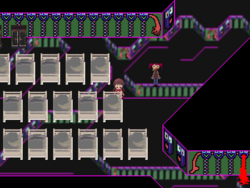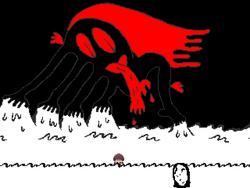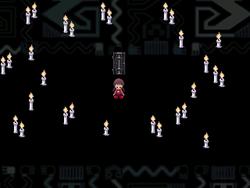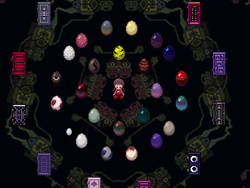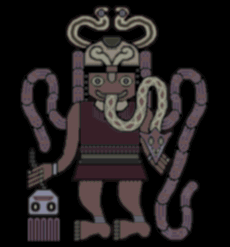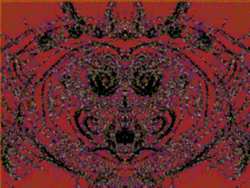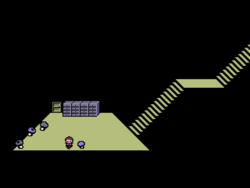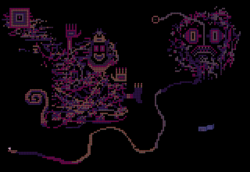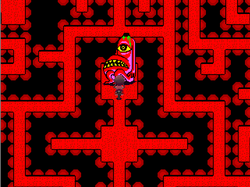The rewritten Style Guide has an open discussion of the spoiler policy. The current policy will be used if no new consensus is reached. Discuss it here.
(Created page with "Welcome to my sandbox. This is where I'll put stuff when I'm experimenting with wiki assets, constructing new pages, or just doing trivial analytical things for fun. ==Specif...") |
No edit summary |
||
| Line 311: | Line 311: | ||
===[[Yume Nikki:Bed Room(name)|Bed Room]]=== | ===[[Yume Nikki:Bed Room(name)|Bed Room]]=== | ||
[[File:Number World Beds.png|thumb|250px]] | [[File:Number World Beds.png|thumb|250px]] | ||
The article makes a connection between the Number World Bed Room and "Naraka", a Buddhist term that is basically the Buddhism equivalent of Hell or purgatory. A being is usually born in Naraka as a result of karma, which may relate to how the Number World Toriningen must be stabbed in order to enter Mini Hell, where a ghost of Madotsuki resides. | The article makes a connection between the Number World Bed Room and "Naraka", a Buddhist term that is basically the Buddhism equivalent of Hell or purgatory. A being is usually born in Naraka as a result of karma, which may relate to how the Number World Toriningen must be stabbed in order to enter Mini Hell, where a ghost of Madotsuki resides. | ||
| Line 320: | Line 319: | ||
===[[Yume Nikki:Bloody Touching Monster(name)|Bloody Touching Monster]]=== | ===[[Yume Nikki:Bloody Touching Monster(name)|Bloody Touching Monster]]=== | ||
[[File:Uboaspace.jpg|thumb|250px]] | [[File:Uboaspace.jpg|thumb|250px]] | ||
The Bloody Touching Monster may be based on the Daidarabotchi of Japanese mythology, a giant who weighed Mount Fuji and Mount Tsukuba on a great scale to see which was heavier. This is similar to how the Bloody Touching Monster is large in size and grabs onto the mountains in the background of Uboa's Trap. The picture in the article also depicts Daidarabotchi as fully black, almost shadow-like, much like the Bloody Touching Monster. | The Bloody Touching Monster may be based on the Daidarabotchi of Japanese mythology, a giant who weighed Mount Fuji and Mount Tsukuba on a great scale to see which was heavier. This is similar to how the Bloody Touching Monster is large in size and grabs onto the mountains in the background of Uboa's Trap. The picture in the article also depicts Daidarabotchi as fully black, almost shadow-like, much like the Bloody Touching Monster. | ||
| Line 327: | Line 325: | ||
===[[Yume Nikki:Candle World(name)|Candle World]]=== | ===[[Yume Nikki:Candle World(name)|Candle World]]=== | ||
[[File:Candleworld.jpg|thumb|250px]] | [[File:Candleworld.jpg|thumb|250px]] | ||
The article first relates Candle World to The Presentation of Jesus at the Temple, which is also known as Candlemas. There are also the Twelve Great Feasts, related to the Presentation of Jesus at the Temple, which the article links to the twelve Nexus doors. It seems that each of the twelve doors in the Nexus represent an event that the Twelve Great Feasts are based on (though the article's table does not just use Nexus doors, it states other non-Nexus worlds like the Pink Sea and Sky Garden Stairway). | The article first relates Candle World to The Presentation of Jesus at the Temple, which is also known as Candlemas. There are also the Twelve Great Feasts, related to the Presentation of Jesus at the Temple, which the article links to the twelve Nexus doors. It seems that each of the twelve doors in the Nexus represent an event that the Twelve Great Feasts are based on (though the article's table does not just use Nexus doors, it states other non-Nexus worlds like the Pink Sea and Sky Garden Stairway). | ||
| Line 397: | Line 394: | ||
===[[Yume Nikki:Dave Spector(name)|Dave Spector]]=== | ===[[Yume Nikki:Dave Spector(name)|Dave Spector]]=== | ||
[[File:Spector.jpg|thumb|220px]] | [[File:Spector.jpg|thumb|220px]] | ||
The article suspects that Dave Spector may be another instance of indigenous imagery in the game. They resemble a Nazca female effigy figure (picture viewable [https://upload.wikimedia.org/wikipedia/commons/f/f0/Nazca_-_Female_Effigy_Figure_-_Walters_2009207.jpg here]) which is made of hair, shell, and whale tooth. | The article suspects that Dave Spector may be another instance of indigenous imagery in the game. They resemble a Nazca female effigy figure (picture viewable [https://upload.wikimedia.org/wikipedia/commons/f/f0/Nazca_-_Female_Effigy_Figure_-_Walters_2009207.jpg here]) which is made of hair, shell, and whale tooth. | ||
| Line 404: | Line 400: | ||
===[[Yume Nikki:Effects (name)|Effects]]=== | ===[[Yume Nikki:Effects (name)|Effects]]=== | ||
[[File:Effect Eggs.png|thumb|250px]] | [[File:Effect Eggs.png|thumb|250px]] | ||
Effects take the form of eggs when they are dropped in the Nexus. The article relates this to Easter eggs, which are special eggs given out around springtime to celebrate Easter. Eggs, which are often used to symbolize rebirth, are used in Christianity to symbolize the empty tomb of Jesus of which he was resurrected from. This could relate to the ending of the game, as many fans view Madotsuki's death as a "rebirth" or "reawakening", and the only way to achieve the ending is through dropping all of the effects (eggs) in the Nexus. The Name article also relates the time that Easter eggs are given out (spring) to a section in the Wilderness article detailing Batsu's similarity to the Asian royal fern, which sprouts in the spring. Batsu also resembles a spiral shape, which is noticed in the Wilderness Name article. In some ancient civilizations, spirals are regarded as a symbol for the cycle of life and death, which could also relate to the "reawakening" ending theory. | Effects take the form of eggs when they are dropped in the Nexus. The article relates this to Easter eggs, which are special eggs given out around springtime to celebrate Easter. Eggs, which are often used to symbolize rebirth, are used in Christianity to symbolize the empty tomb of Jesus of which he was resurrected from. This could relate to the ending of the game, as many fans view Madotsuki's death as a "rebirth" or "reawakening", and the only way to achieve the ending is through dropping all of the effects (eggs) in the Nexus. The Name article also relates the time that Easter eggs are given out (spring) to a section in the Wilderness article detailing Batsu's similarity to the Asian royal fern, which sprouts in the spring. Batsu also resembles a spiral shape, which is noticed in the Wilderness Name article. In some ancient civilizations, spirals are regarded as a symbol for the cycle of life and death, which could also relate to the "reawakening" ending theory. | ||
| Line 432: | Line 427: | ||
===[[Yume Nikki:Eyeball World(name)|Eyeball World]]=== | ===[[Yume Nikki:Eyeball World(name)|Eyeball World]]=== | ||
[[File:Eyeball.png|thumb|250px]] | [[File:Eyeball.png|thumb|250px]] | ||
The Medamaude NPC that gives the Medamaude effect resembles the hamsa, a palm-shaped amulet depicting an open right hand with an eye on the palm. The sign represents protection, which could relate to how the Medamaude effect returns Madotsuki to the peaceful Nexus while remaining asleep, especially in a situation where she is lost or trapped by characters such as Uboa or the Toriningen. | The Medamaude NPC that gives the Medamaude effect resembles the hamsa, a palm-shaped amulet depicting an open right hand with an eye on the palm. The sign represents protection, which could relate to how the Medamaude effect returns Madotsuki to the peaceful Nexus while remaining asleep, especially in a situation where she is lost or trapped by characters such as Uboa or the Toriningen. | ||
The Eyeball World background also heavily resembles Paracas textile work, depicting a dream being that is an often reoccurring design throughout Paracas textiles. This being represents the dreamer and acts as a sort of self-awareness during dreams to signify that the person is in fact dreaming. The figure also holds the head of the dreamer. | The Eyeball World background also heavily resembles Paracas textile work, depicting a dream being that is an often reoccurring design throughout Paracas textiles. This being represents the dreamer and acts as a sort of self-awareness during dreams to signify that the person is in fact dreaming. The figure also holds the head of the dreamer. | ||
While the background obviously takes inspiration from the Paracas, it may also be inspired by the Native American sun dance ritual. One of the members of the dance wears a red loincloth with no upper-body wear, face paint, a packet of tobacco around their neck, and sage rings around their head and wrists. This description slightly fits the Eyeball World background, as it wears red, has rings around its wrists (and ankles), and also some sort of neck attachment. The sun dancer also holds an eagle bone flute in their mouth during the sun dance, blowing it in order to | While the background obviously takes inspiration from the Paracas, it may also be inspired by the Native American sun dance ritual. One of the members of the dance wears a red loincloth with no upper-body wear, face paint, a packet of tobacco around their neck, and sage rings around their head and wrists. This description slightly fits the Eyeball World background, as it wears red, has rings around its wrists (and ankles), and also some sort of neck attachment. The sun dancer also holds an eagle bone flute in their mouth during the sun dance, blowing it in order to attract eagles. It was considered good luck if eagles flew down due to the flute's sound, as they were considered the ''eyes'' of the heavens. | ||
===[[Yume Nikki:FACE(name)|FACE]]=== | ===[[Yume Nikki:FACE(name)|FACE]]=== | ||
[[File:Yn-face.png|thumb|250px]] | [[File:Yn-face.png|thumb|250px]] | ||
FACE resembles various drawings and paintings by the artist Louis Wain, who particularly drew cats. Some of his later works depicted more surreal and abstract representations of cat faces. | FACE resembles various drawings and paintings by the artist Louis Wain, who particularly drew cats. Some of his later works depicted more surreal and abstract representations of cat faces. | ||
| Line 448: | Line 441: | ||
===[[Yume Nikki:FC World(name)|FC House]]=== | ===[[Yume Nikki:FC World(name)|FC House]]=== | ||
[[File:Screenshot (9).png|thumb|250px]] | [[File:Screenshot (9).png|thumb|250px]] | ||
FC World obviously takes inspiration from classic Famicom/NES games, though ''Mother'' (also known as ''EarthBound Beginnings'') appears to be one of the more significant and obvious inspirations. | |||
FC World obviously takes inspiration from classic Famicom/NES games, though ''Mother'' (also known as ''EarthBound Beginnings'') appears to be one of the more significant inspirations. | |||
The next installment in the ''Mother'' series, ''Mother 2''/''EarthBound'', has the beginning of the story start with a meteor crash. This may have inspired the NPC Merutomaro, who resembles star jelly. Star jelly is a gelatinous substance that, in folklore, is stated to fall during meteor showers. The substance also often takes a primarily white color, matching Merutomaro's appearance. Considering this slime and meteor connection to Merutomaro, they may also be based on the monster from ''The Blob'', who comes from outer space on a meteorite. The term "blob" can also stand for "binary large object", a collection of binary data in a single entity, which is befitting of the retro/digital/game-theme of the world Merutomaro lives in. | The next installment in the ''Mother'' series, ''Mother 2''/''EarthBound'', has the beginning of the story start with a meteor crash. This may have inspired the NPC Merutomaro, who resembles star jelly. Star jelly is a gelatinous substance that, in folklore, is stated to fall during meteor showers. The substance also often takes a primarily white color, matching Merutomaro's appearance. Considering this slime and meteor connection to Merutomaro, they may also be based on the monster from ''The Blob'', who comes from outer space on a meteorite. The term "blob" can also stand for "binary large object", a collection of binary data in a single entity, which is befitting of the retro/digital/game-theme of the world Merutomaro lives in. | ||
| Line 459: | Line 451: | ||
===[[Yume Nikki:Graffiti World(name)|Graffiti World]]=== | ===[[Yume Nikki:Graffiti World(name)|Graffiti World]]=== | ||
[[File:Graffiti World.png|thumb|250px]] | [[File:Graffiti World.png|thumb|250px]] | ||
Graffiti World's tile-like layout appears to be inspired by the game ''LSD: Dream Emulator'', which is based on a dream journal kept by Hiroko Nishikawa. The game has a similar feel to ''Yume Nikki'', relying on dream-like visuals and player exploration. This inspiration may be why the Bicycle effect can be found here, as "LSD" is also a drug. The first recorded LSD trip is known as "Bicycle Day" where Swiss chemist Dr. Albert Hofmann ingested the substance and reported intense perception changes. His assistant helped escort him out, and the two rode on bicycles in order for Hofmann to reach his house. | Graffiti World's tile-like layout appears to be inspired by the game ''LSD: Dream Emulator'', which is based on a dream journal kept by Hiroko Nishikawa. The game has a similar feel to ''Yume Nikki'', relying on dream-like visuals and player exploration. This inspiration may be why the Bicycle effect can be found here, as "LSD" is also a drug. The first recorded LSD trip is known as "Bicycle Day" where Swiss chemist Dr. Albert Hofmann ingested the substance and reported intense perception changes. His assistant helped escort him out, and the two rode on bicycles in order for Hofmann to reach his house. | ||
Revision as of 09:00, 22 November 2022
Welcome to my sandbox. This is where I'll put stuff when I'm experimenting with wiki assets, constructing new pages, or just doing trivial analytical things for fun.
Specific World Exploration
Documenting how the dream world can be explored under certain conditions and other various things related to the dream world. Click Expand to view contents.
Name Articles
The "Name" articles are a series of articles originally created by Mt.kiki on the old Yume Nikki Wiki. These pages list various theories relating to Yume Nikki and possible design inspirations for various aspects of the game. As the articles (likely) provide a Japanese point-of-view on the game's visuals and themes, they are likely to give better insight into possible design processes while creating Yume Nikki.
As the articles are either largely written in Japanese, have broken Google-Translated English, or are copy-pasted from other websites, I'd like to try and see if I could decode what each of the article's sections intends to communicate. This is also done to squeeze the contents of the articles into a smaller, usually multi-paragraph, state so that it can be read from a single section rather than an entire article.
Not all of the articles have currently been analyzed or translated, so this is still a work-in-progress section. Once one has been completed, an image will accompany the section.
Click Expand to view contents.

